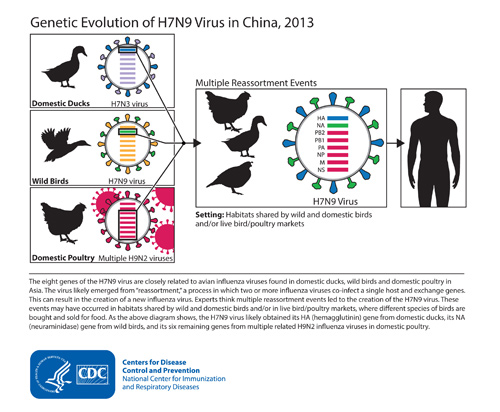Avian Influenza (Flu) Viruses
The Wicomico County Health Department has been an active participant in the Delmarva Avian Influenza Task Force since its inception. Public Health assists in the planning, response and follow-up of human health as it relates to the overall response to control measures.
Highly Pathogenic Avian Influenza (HPAI) A (H5N1)
 H5N1 (Bird) flu virus is an influenza A virus subtype that is highly contagious among birds, and can be deadly to them. The H5N1 (Bird) flu virus does not usually infect people, but rare infections with these viruses have occurred in humans. Nearly all human cases have resulted from people having direct or close contact with H5N1-infected poultry or H5N1-contaminated surfaces.
H5N1 (Bird) flu virus is an influenza A virus subtype that is highly contagious among birds, and can be deadly to them. The H5N1 (Bird) flu virus does not usually infect people, but rare infections with these viruses have occurred in humans. Nearly all human cases have resulted from people having direct or close contact with H5N1-infected poultry or H5N1-contaminated surfaces.
Symptoms of the H5N1 (Bird) flu virus in humans have ranged from (e.g., fever, cough, sore throat, and muscle aches) to eye infections, pneumonia, severe respiratory diseases (such as acute respiratory distress), and other severe and life-threatening complications. The symptoms of H5N1 (Bird) flu may depend on which virus caused the infection.
Avian Influenza A (H7N9) Virus

Human infections with a new avian influenza A (H7N9) virus were first reported in China in March 2013. Most of these infections are believed to result from exposure to infected poultry or contaminated environments, as H7N9 viruses have also been found in poultry in China. While some mild illnesses in human H7N9 cases have been seen, most patients have had severe respiratory illness, with about one-third resulting in death. No evidence of sustained person-to-person spread of H7N9 has been found, though some evidence points to limited person-to-person spread in rare circumstances. The first case outside of China was in Malaysia and was reported on February 12, 2014. The case was detected in a traveler from an H7N9-affected area of China. The new H7N9 virus has not been detected in people or birds in the United States.
It’s likely that sporadic cases of H7N9 associated with poultry exposure will continue to occur in China. It’s also possible that H7N9 may spread to poultry in neighboring countries and that human cases associated with poultry exposure may be detected in those neighboring countries. It’s also possible that H7N9 cases may continue to be detected among travelers returning from H7N9-affected countries, even possibly in the United States at some point. However, as long as there is no evidence of ongoing, sustained person-to-person spread of H7N9, the public health risk assessment would not change substantially. Most concerning about this situation is the pandemic potential of this virus. Influenza viruses constantly change and it’s possible that this virus could gain the ability to spread easily and sustainably among people, triggering a global outbreak of disease (pandemic). The U.S. Government supports international surveillance for H7N9 and other influenza viruses with pandemic potential. CDC is following the H7N9 situation closely and coordinating with domestic and international partners. Most important, is CDC takes routine preparedness actions whenever a new virus with pandemic potential is identified, including developing a candidate vaccine virus to make a vaccine in case vaccine is needed. Those preparedness measures continue. CDC also has issued guidance to clinicians and public health authorities in the United States, as well as provided information for people traveling to China. CDC will provide updated information as it becomes available.

